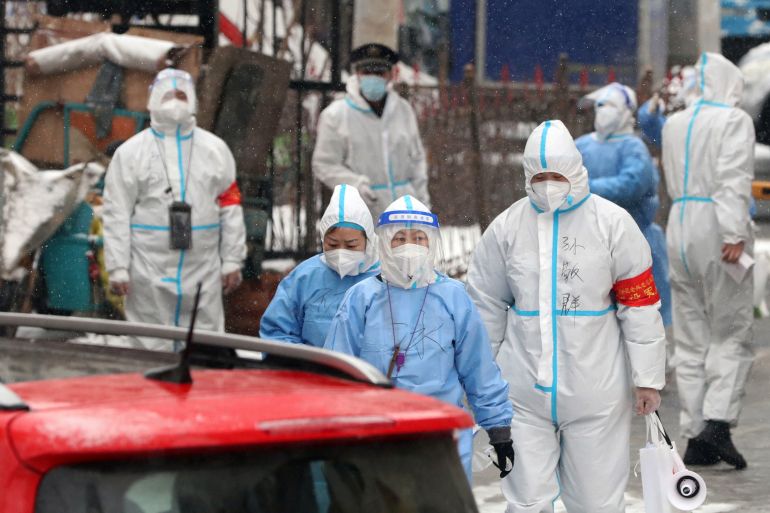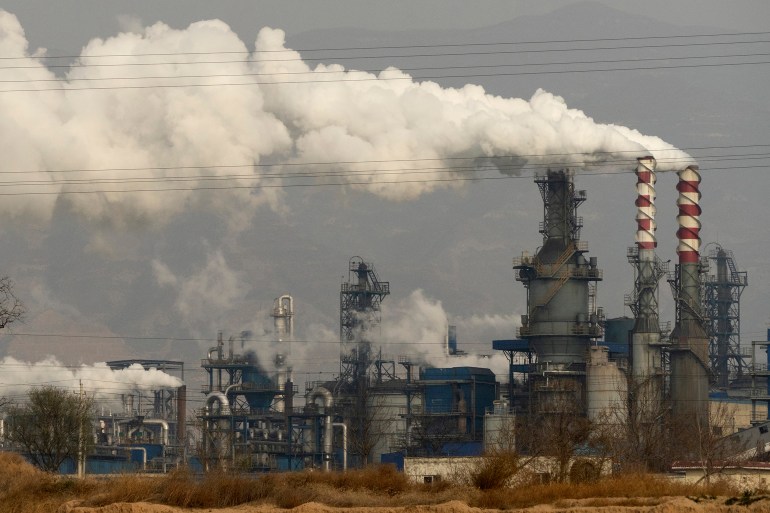Feeling economic strain, China explores tweaks to ‘Zero COVID’

China’s biggest lockdown since the pandemic began is testing Beijing’s pledge to minimise the economic fallout of its strict “dynamic Zero COVID” strategy.
Shanghai, China’s biggest city and financial capital, will be locked down in two phases over nine days, as authorities seek to lessen the economic disruption of its zero-tolerance approach to COVID-19.
Keep reading
list of 4 itemsWill Smith apologises to Chris Rock over Oscars slap
Peru’s president avoids impeachment after marathon debate
Honduras top court OKs ex-President Hernandez’s extradition to US
The city’s Pudong financial district and nearby areas – the section east of the Huangpu River that runs through Shanghai – will be locked down until Friday as residents are confined to their homes for mass testing. Once testing is complete in Pudong, the downtown area west of the river will begin its own four-day lockdown.
The targeted lockdowns and mass testing come as China explores ways to tweak its draconian pandemic policies as the spread of the highly transmissible Omicron variant makes eliminating the virus increasingly difficult and costly.
Last week, China’s National Health Commission issued new guidelines narrowing the geographic scope of mass testing and stipulating that local governments should complete testing of each designated area within 24 hours. The announcement came after China’s President Xi Jinping earlier this month pledged to achieve “maximum prevention and control” while minimising damage to China’s economic and social development
“Basically, this means residents won’t have to be stuck in their neighbourhoods or apartments for as long as before,” Taylor Loeb, an analyst at Trivium China, told Al Jazeera.
“Testing should be both faster and more targeted and, ideally, cause less disruption to people’s lives and business activities. This is an adjustment rather than a softening of Zero COVID. It shows that Beijing is trying to make testing less of a social and economic burden by making it more efficient, as opposed to limiting it.”

Other fine-tuning measures include encouraging large factories to adopt a “closed-loop” arrangement that will enable them to keep some operations running during lockdowns, using rapid antigen tests, raising the viral load threshold for testing positive, allocating health resources to vulnerable patients, and allowing mild and asymptomatic cases to quarantine in isolation facilities rather than hospitals.
“To reduce the economic impact of COVID restrictions, the government is fine-tuning its COVID strategy to reduce the time that activities will be restricted,” Tommy Wu, lead economist at Oxford Economics in Hong Kong, told Al Jazeera.
“These recent developments mark some loosening of the Zero COVID strategy. China will likely continue to adjust its COVID strategy as authorities gain experience in handling Omicron cases.”
China’s zero-tolerance approach towards COVID-19 during the two years has slowed domestic spending and disrupted global supply chains, raising questions about its long-term sustainability. The tough approach is also increasingly at odds with the international consensus on how to manage the pandemic as other parts of the world lift restrictions and move towards living with the virus. Despite the significant disruption caused by ongoing lockdowns and mass testing, Beijing has repeatedly signalled it is not willing to live with the virus.
Hong Kong, which is facing an exodus of foreign firms and talent over its harsh pandemic rules, has moved to lift flight bans on nine countries, reduce mandatory hotel quarantines for arrivals from 14 to 7 days, and ease social-distancing measures over a three-month period. But elsewhere in China, strict pandemic rules remain largely unchanged, leading to growing signs of frustration among a population that has largely accepted Beijing’s strategy without complaint.
Mandatory hospitalisation of positive cases has strained Shanghai’s medical system, while the recent death of a nurse in the city who was denied a hospital place in Shanghai after suffering an asthma attack outraged many Chinese. On China’s heavily censored Internet, some users have posted comments questioning whether Zero-COVID policies may be causing more harm than the virus itself.
Despite not covering the entire city at once, the Shanghai lockdown is the most wide-reaching set of restrictions since the pandemic began, affecting some 25 million people, and comes after authorities had resisted such a move out of concern for the economy.
Record surges
On Friday, China reported nearly 5,000 Omicron cases, the largest single-day surge since the coronavirus emerged in Wuhan in late 2019.
Shanghai authorities on Tuesday reported a record 4,381 asymptomatic cases and 96 symptomatic cases – leading authorities to tighten restrictions further by asking residents to stay indoors except for trips to get tested.
Last week, Shenyang – an industrial city with a population of approximately 9 million people – went into lockdown, barring residents from leaving their homes without a 48-hour negative test result.
“The Chinese government seems to have realised that its Zero-COVID policy has put overwhelming pressure on its economy, so it’s now tweaking its anti-covid measures,” Tianlei Huang, a research fellow at the Peterson Institute for International Economics in Washington, DC, told Al Jazeera.
“When there is less daily life interruption, there is less slowdown of economic activity,” Huang said.
Still, Beijing has made it clear it will not tolerate uncontrolled outbreaks of the virus.
“Rather than adopting a ‘live with the virus’ approach like many other countries, China is making testing more efficient. Given that the Party Congress is coming up in about six months, it’s unlikely that we’ll see a substantial relaxation of COVID restrictions,” Loeb said.
More subtle changes, however, may be in the offing.
Authorities’ handling of the virus already tends to be less restrictive the further away they are from Beijing, according to data from New York-based China Beige Book, with Shanghai’s two-phase lockdown just one example of a more targeted approach.
“We’ve now officially entered the era of Zero COVID 2.0,” Shehzad Qazi, managing director of China Beige Book International, told Al Jazeera.
Qazi said China’s COVID response moving forward may look less like Wuhan in 2020 and more like Shenzhen in 2022, which allowed businesses to resume operations within days of its most recent lockdown.
“China is no longer relying on blanket lockdowns in its metropolitan cities and is instead prioritising keeping commerce alive while attempting to limit the spread,” he said. “The reasons are clear: Chinese consumption suffered throughout 2021 in large part due to lockdowns suppressing growth. The [Chinese Communist] Party can scarcely afford additional economic pain, especially in this politically sensitive year.”